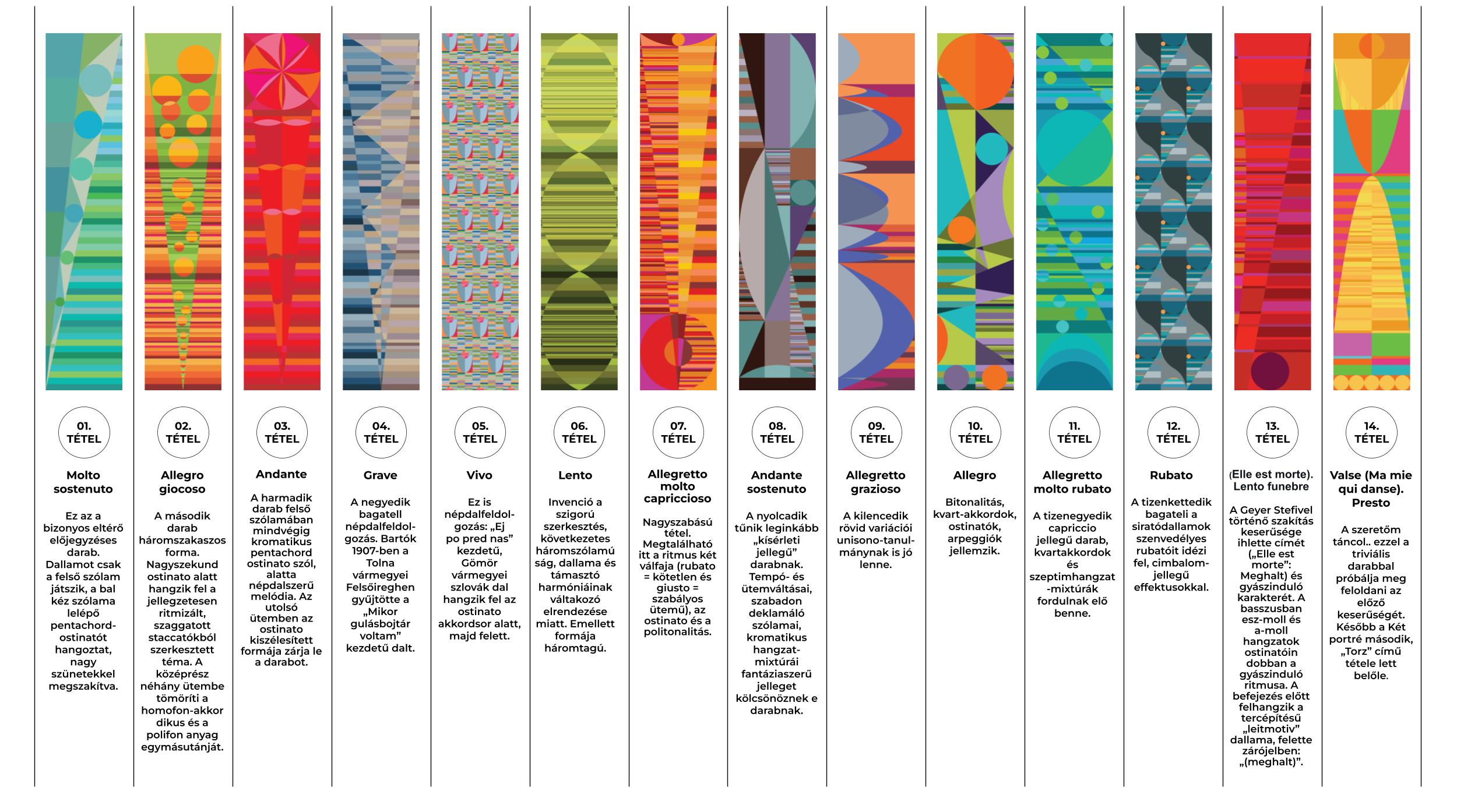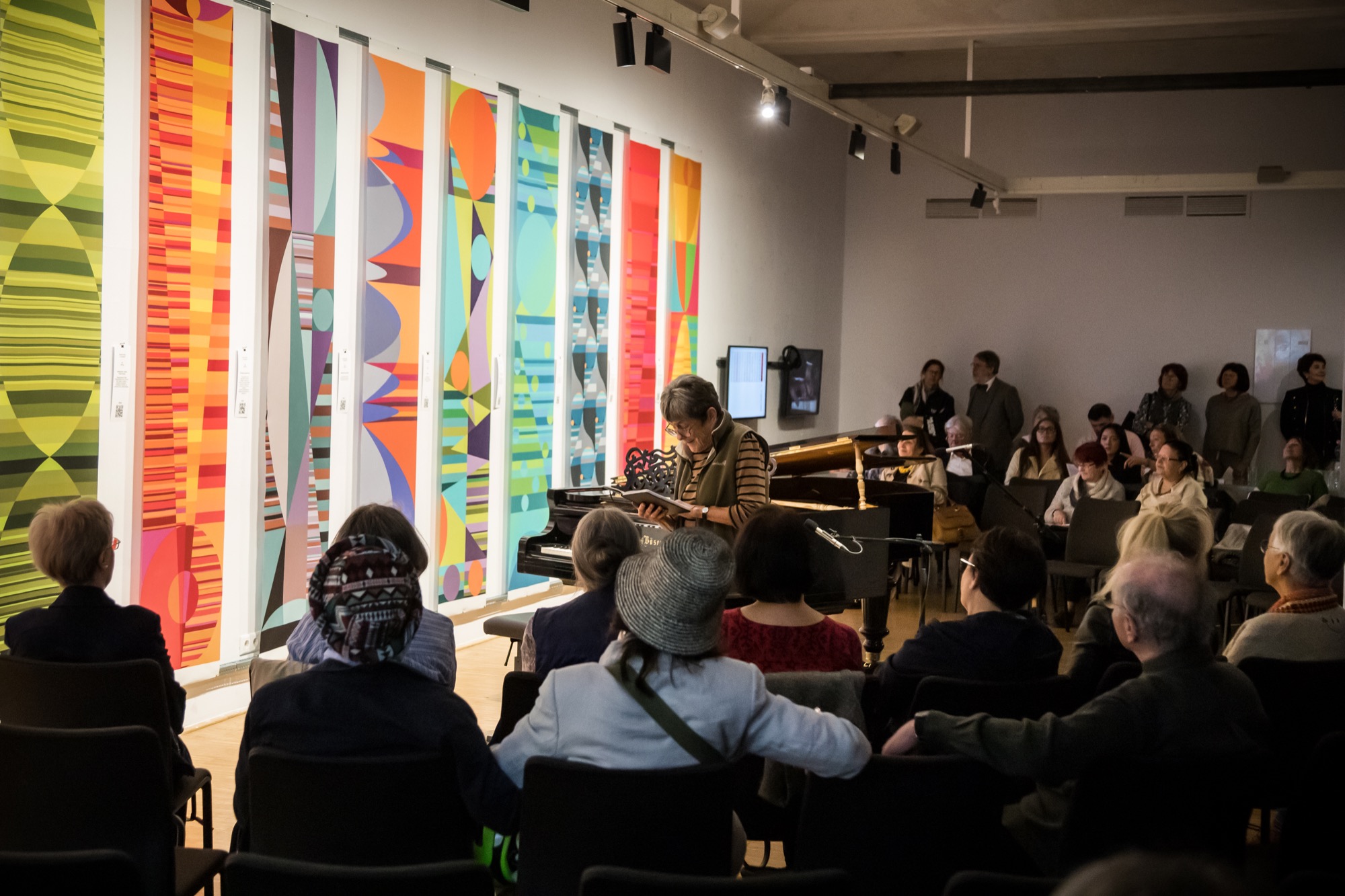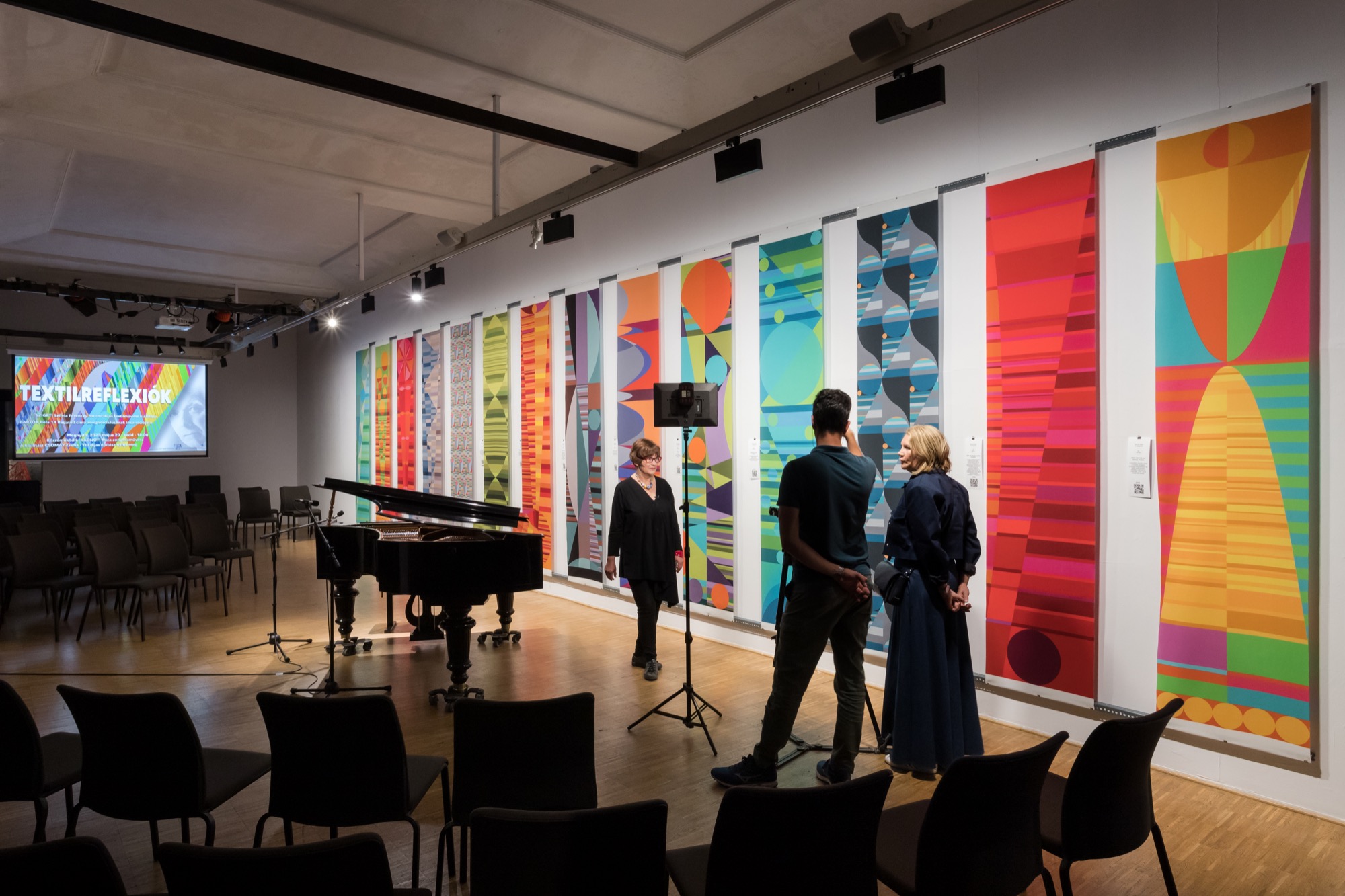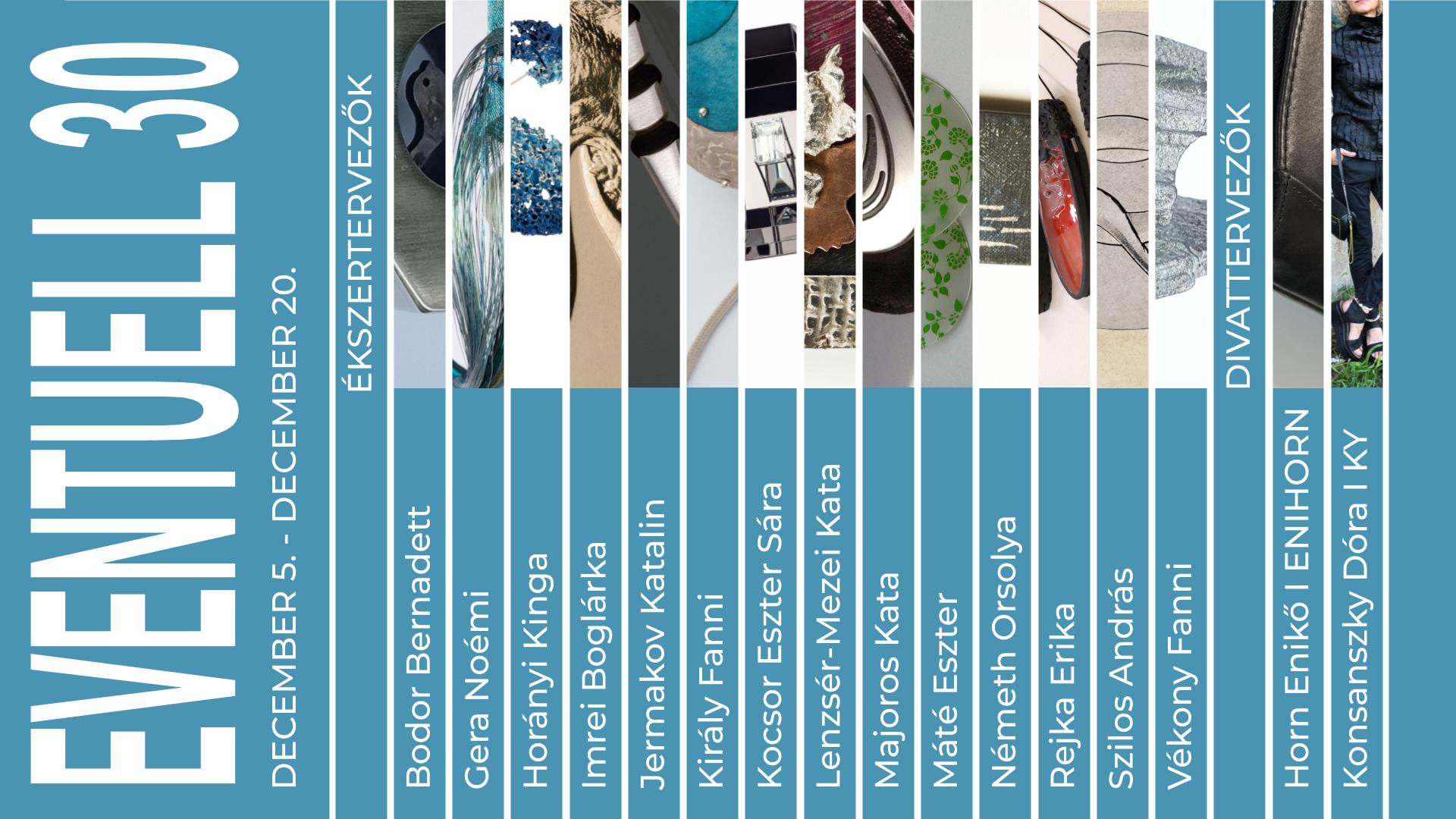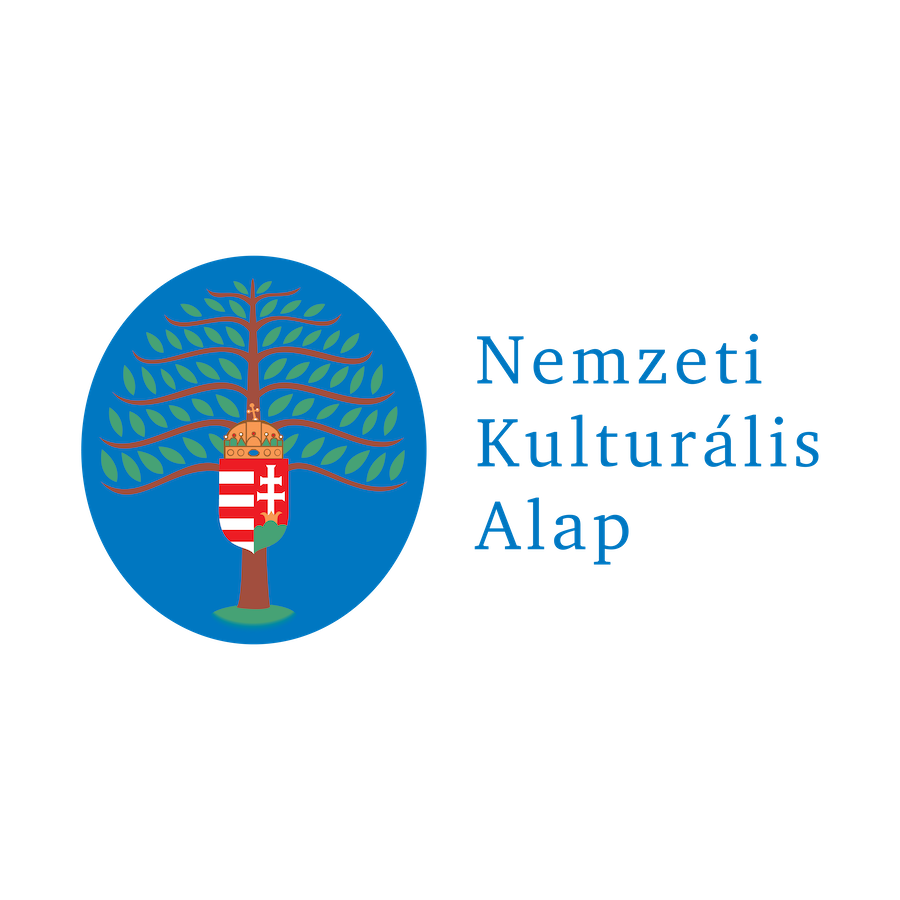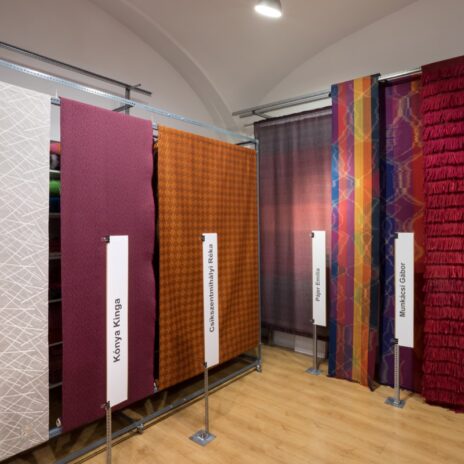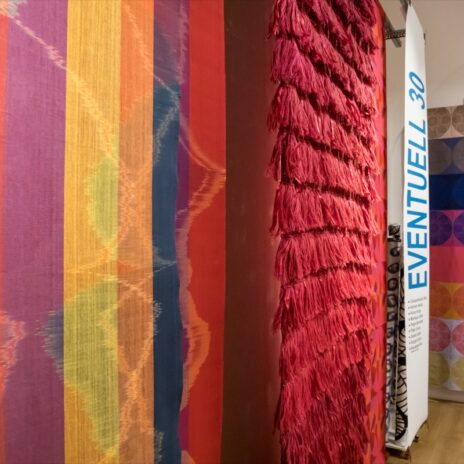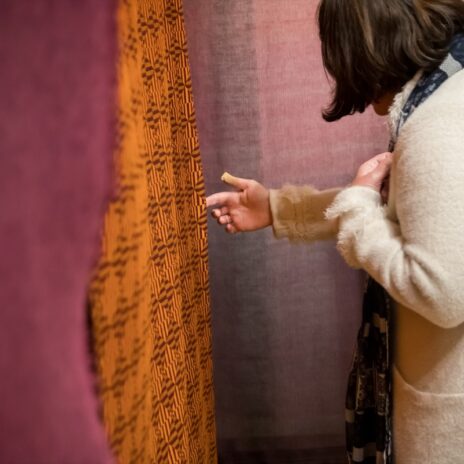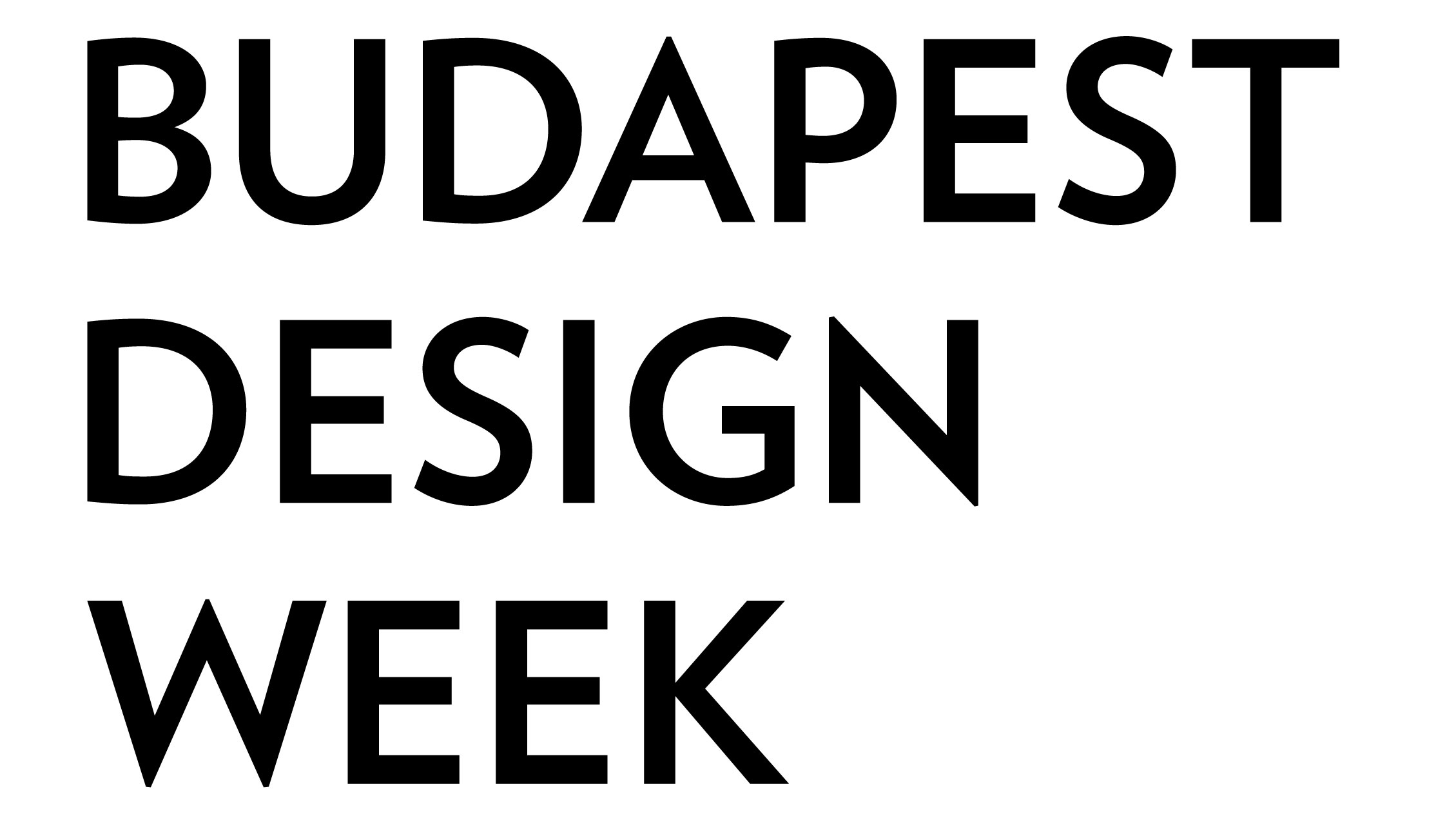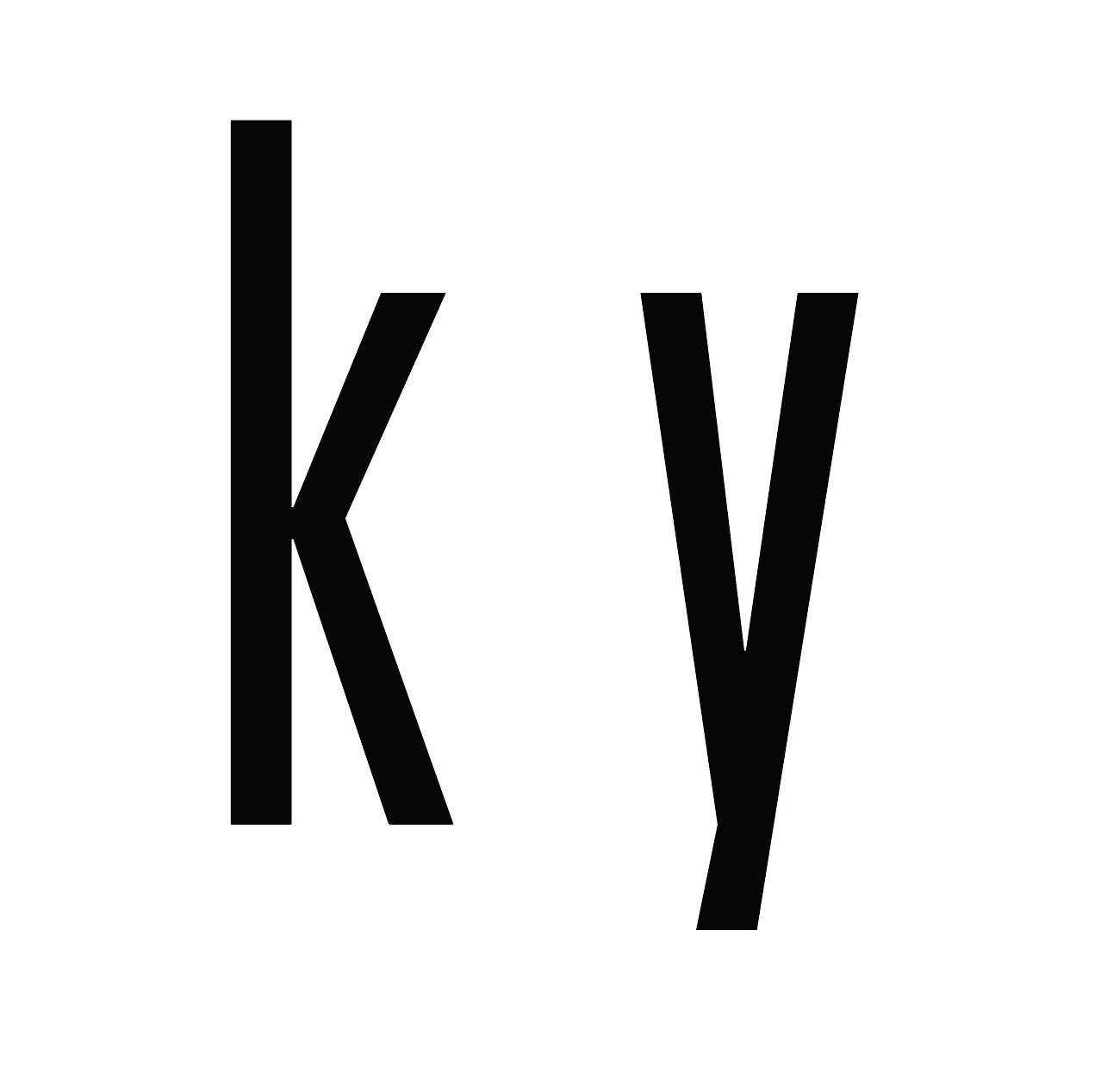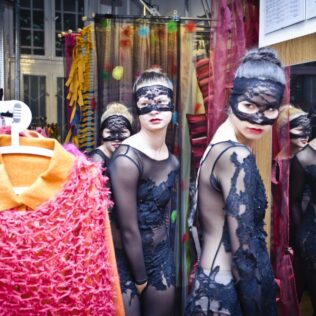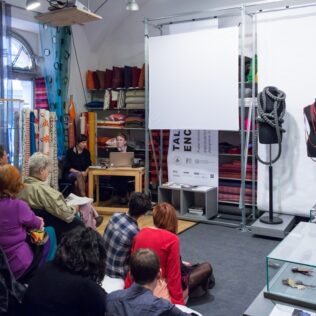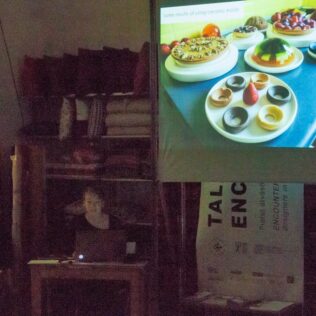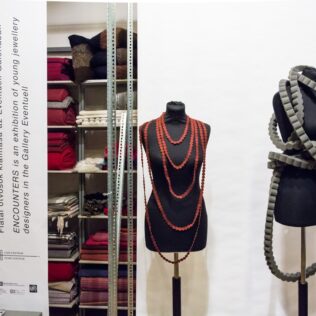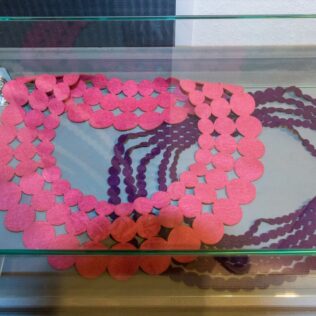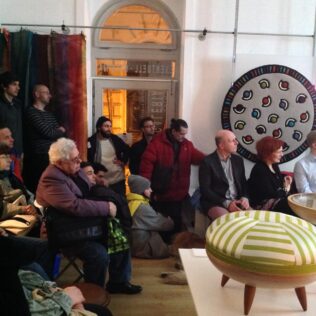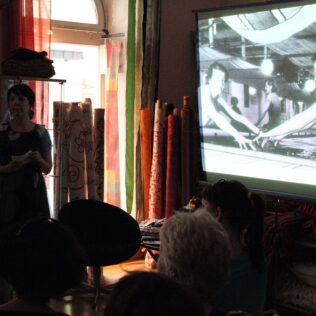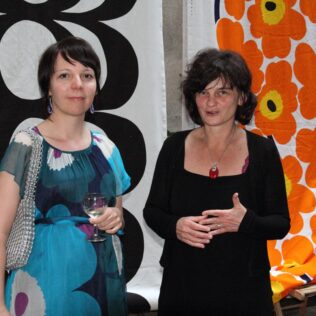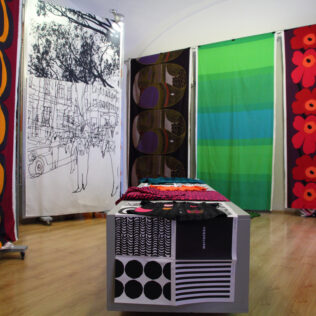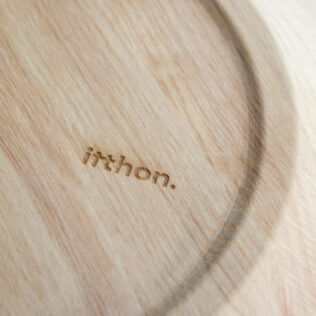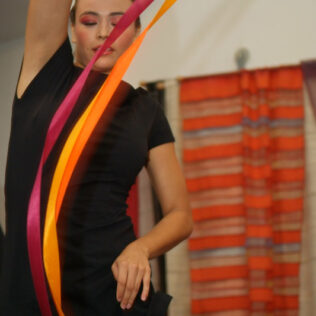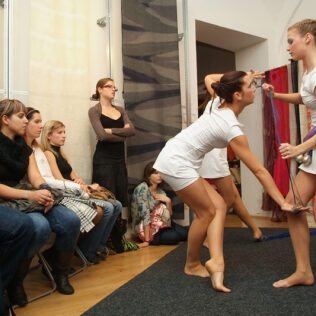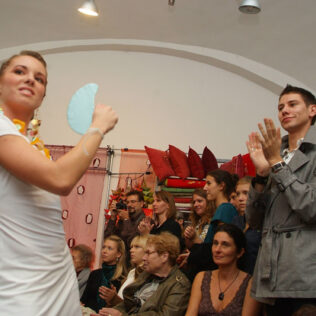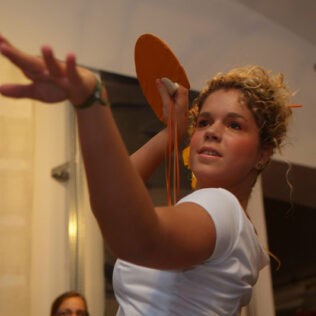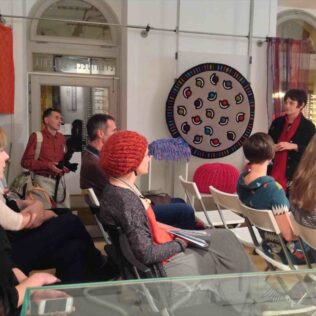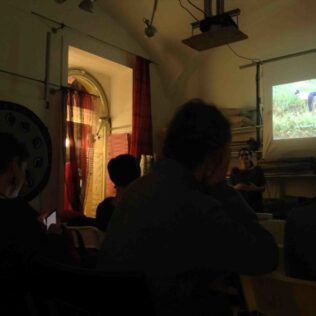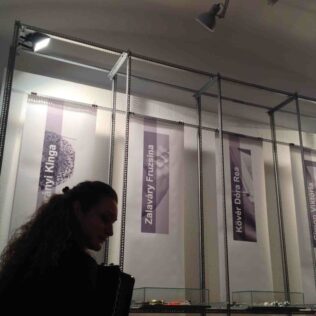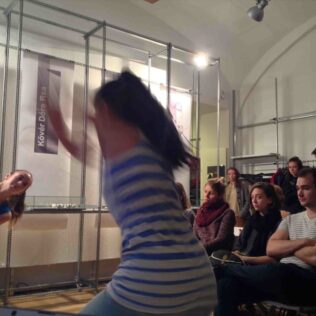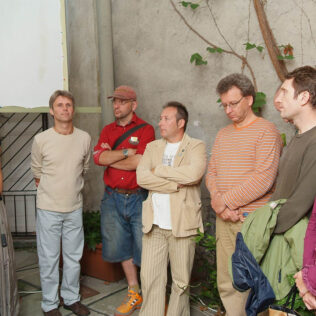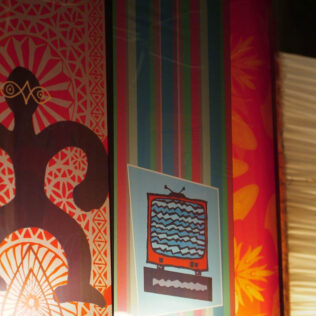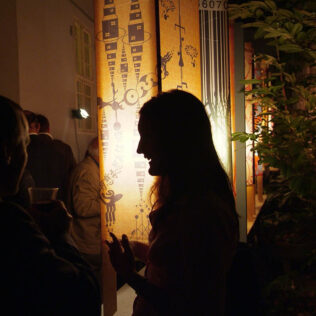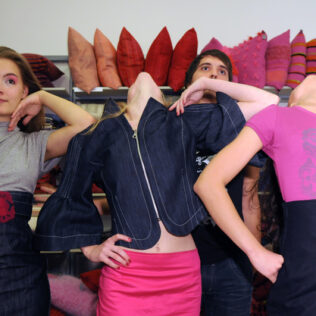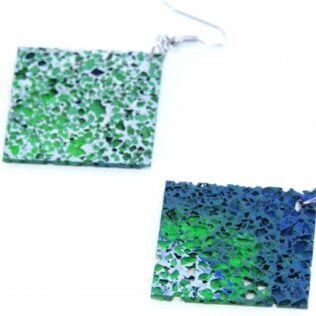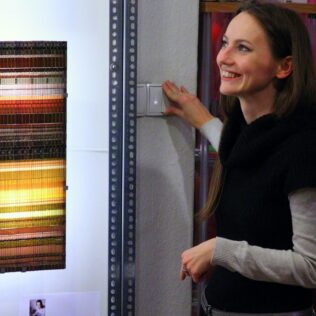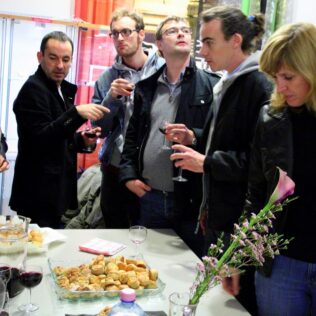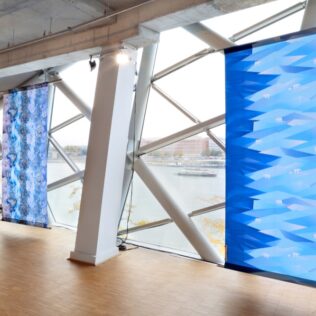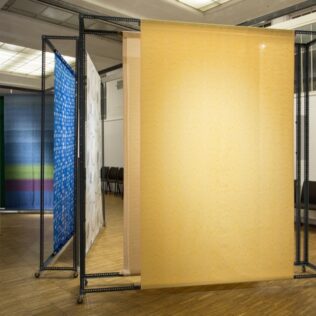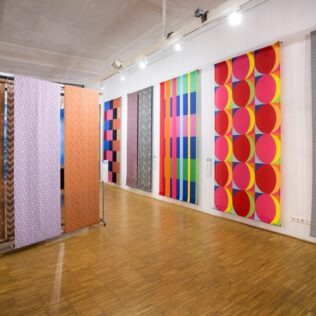PREVIOUS EXHIBITION / ELŐZŐ KIÁLLÍTÁS: 2024 DECEMBER 5 - DECEMBER 21
PREVIOUS EXHIBITION:
EVENTUELL 30
18 October – 17 November 2024
ELŐZŐ KIÁLLÍTÁS:
EVENTUELL 30
2024. október 18 - november 17
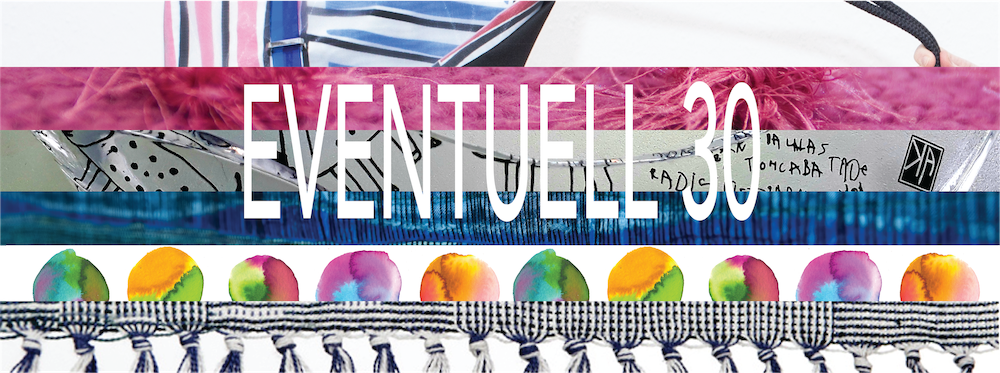
Csíkszentmihályi Réka, Harmati Hedvig, Kónya Kinga, Munkácsi Gábor, Páger Bernadett, Pájer Emília, Szabó Zsuzsi és Szigeti Szilvia textilművészek és Keresztes Nóra textiltervező, MOME MA hallgató kiállítása
Eventuell Gallery
The predecessor of Eventuell Gallery, Eventuell Studio was founded in 1994.
The founding members are Kinga Kónya, Gábor Munkácsi, Zsuzsi Szabó and Szilvia Szigeti textile-designers, as well as Tamás Radnóti interior designer.
Rightfully, we can be proud that Eventuell Gallery is considered an outstanding example of the collaboration between designers.
Our group is open and self-organized, a creative community of freelance designers.
Owing to this, in addition to most of the founding members, many new ones have joined us over the years.
Apart from the textile-and interior designers, jewellers and fashion designers are among us as well.
Our designers create unique items in a limited quantity.
The use of various traditional techniques, adapted in a contemporary way, the creative use of materials, material association and an organic approach is a common feature of our designers in their own field.
The exhibitors take part in numerous national and international exhibitions, professional events and trade fairs individually and with the company aslo.
The current members of Eventuell Gallery are Kinga Kónya, Gábor Munkácsi, Emília Pájer, Bernadett Páger and Szilvia Szigeti textile-designers, Kinga Horányi, Eszter Máté, Rejka Erika jewellery designers, the Blue Paprika company; Szilvia Pálffy and Teréz Szűcs fashion designers as well as Tamás Radnóti interior designer.
In Eventuell Gallery, since 1994, on the nearly 80 exhibitions and events organized by Szilvia Szigeti and Tamás Radnóti – in addition to presenting the works of the permanent members – two-hundred, mainly contemporary and entrant, hungarian and foreign designers, craftsmen, and fellow artists have made their debut.
When the customer enters, the first thing noticed is an incredibly colorful spectacle of items.Claret, red, brillant, orange, grass-green, custom-made and limited series of woven, „Ikat“ style woven, embroidered, printed textiles, curtains, cushions, cloths, bedspreads, scarves, stoles, custom-made lamps, exciting, astonishing applicated jewellery, ambiguously humorous, „folk-inspired“ denim wear and T-shirts welcome the visitors.
Along with the store’s other products, our designers create custom made items as well, according to individual needs, such as unique curtains, interior design and counselling, textile design, custom-made jewellery, garments and dresses.
We warmly welcome everyone, who would like to buy directly from the designers, who are interested in unique home furnishings, items, jewellery, accessories and clothes, those who would like to distinguish themselves and INDIVIDUALISM is an important thing in their style and in their home.
Az Eventuell Galéria elődje, az Eventuell Studió 1994-ben alakult. Alapító tagjai: Kónya Kinga, Munkácsi Gábor, Szabó Zsuzsi, Szigeti Szilvia textiltervezők és Radnóti Tamás belsőépítész. Joggal lehetünk büszkék arra, hogy az Eventuell Galériát a designerek közötti összefogás példaképének tartják. A csoportunk nyitott, önszerveződő, egyéni utakat járó tervezőkből álló alkotóközösség. Ennek köszönhető, hogy az alapító tagok nagy részén kívül az évek során sok új tag csatlakozott hozzánk. A textiltervezőkön, belsőépítészen kívül ékszertervezők és divattervezők is tagjai a csoportnak. A tervezők egyedi és kisszériás tárgyakat hoznak létre. Mindannyiukra jellemző a saját szakterületükön, a különböző tradicionális technikák felhasználása, mai korra jellemző átírása, a kreatív anyaghasználat, anyagtársítás, az organikus szemléletmód. A kiállítók egyénileg és csoportosan is számtalan hazai és külföldi kiállításon, szakmai rendezvényen és szakvásáron vesznek részt. Az Eventuell Galéria jelenlegi tagjai: Kónya Kinga, Munkácsi Gábor, Pájer Emília, Páger Bernadett és Szigeti Szilvia textiltervezők, Horányi Kinga, Máté Eszter, Rejka Erika ékszertervezők, a Blue Paprika: Pálffy Szilvia és Szűcs Teréz divattervezők, valamint Radnóti Tamás belsőépítész.
Az Eventuell Galériában 1994 óta Szigeti Szilvia és Radnóti Tamás által szervezett kiállításokon és különböző rendezvényeken - az állandó tagok munkáinak bemutatásán kívül - eddig közel 80 kiállításon 200, főleg kortárs és pályakezdő, magyar és külföldi designer, iparművész, társművész mutatkozott be.
A látogatók nagyon színes tárgykavalkádba lépnek be.Bordó, vörös, brillant, narancs, fűzöld, egyedi és kisszériás szövött, “ikat”, kötött, hímzett, nyomott textilek, függönyök,párnák, terítők, ágytakarók, sálak, stólák, egyedi lámpák, izgalmas, meghökkentő anyagtársítású applikált ékszerek, frivol humorú, “folkinspirációjú” jeans öltözékek, pólók fogadják az érdeklődőket.
A galériában található kínálaton kívül a tervezők bármi, szakmába vágót vállalnak egyéni igény szerint, mint pl. egyedi lakásfüggönyzést, belsőépítészeti tervezést, lakberendezési tanácsadást, textiltervezést, egyedi ékszerek, öltözékek elkészítését.
Szeretettel várunk Mindenkit, aki közvetlenül a tervezőktől szeretne vásárolni, érdeklődik az egyedi lakástextilek, tárgyak, ékszerek öltözékkiegészítők és öltözékek iránt, szeretné magát megkülönböztetni és fontos számára az INDIVIDUÁLIS az öltözékében és az otthonában!
Exhibition opening
Eventuell 30
Opening of the textile exhibition of the anniversary exhibition series to celebrate the 30th anniversary of the founding of the Eventuell Gallery
Celebrating its 30th anniversary, Eventuell is one of the most influential creative workshops, which, in addition to the home textiles, clothing accessories, unique bags and contemporary jewellery of its members, has presented hundreds of works by hundreds of artists in nearly 300 exhibitions over the years.
The first exhibition in the series will showcase the works of the founding textile artists, former and current permanent studio members – textile artists Réka Csíkszentmihályi, Hedvig Harmati, Kinga Kónya, Gábor Munkácsi, Bernadett Páger, Emilia Pájer, Zsuzsi Szabó and Szilvia Szigeti, as well as the work of Nóra Keresztes young textile designer, currently MA student at MOME.
The exhibition will be opened by Nóra Demeter DLA architect.
Contributing to the opening will be flautist Zselyke Fehér student of LFZE.
Exhibition opening: 17 October 2024, 18:00
Requires registration.
Register until 15 October – szilvisziget@gmail.com
Exhibition dates: 18 October – 17 November 2024
Opening hours: Thu – Fri: 11:00 – 18:00, Sat: 10:30 – 14:00
The exhibition is part of Budapest Design Week.
Kiállítás megnyitó
Eventuell 30
Jubileumi kiállítássorozat textiles kiállításának megnyitója az Eventuell Galéria alapításának 30. évfordulója alkalmából
A 30. évfordulóját ünneplő Eventuell az egyik legmeghatározóbb alkotóműhely, amely a studio tagjainak lakástextiljein, öltözék kiegészítőin, egyedi táskáin, kortárs ékszerein kívül az évek során közel 300 kiállítás alkalmával több száz alkotó munkáit mutatta be.
A sorozat első kiállítása az alapító textilművészek, korábbi és jelenlegi állandó stúdiótagok
munkáit - Csíkszentmihályi Réka, Harmati Hedvig, Kónya Kinga, Munkácsi Gábor, Páger Bernadett, Pájer Emília, Szabó Zsuzsi és Szigeti Szilvia textilművészek és Keresztes Nóra textiltervező, MOME MA hallgató textiljeit mutatja be.
A kiállítást Demeter Nóra DLA építész nyitja meg. Közreműködik: Fehér Zselyke (fuvola) az LFZE hallgatója.
Kiállításmegnyitó: 2024 október 17. 18:00
Regisztrációhoz kötött
Regisztráció: október 15-ig - szilvisziget@gmail.com
A kiállítás időtartama: 2024. október 18 - november 17.
Nyitva tartás: Cs - P: 11:00 - 18:00, Szo.:10:30 - 14:00
A kiállítás a Budapest Design Week programsorozat része.
TEXHIBITION, initiated in 2014 by Ferenczy Noémi Award-winning textile artist Szilvia Szigeti, aims to raise awareness of the once significant Hungarian textile industry, textile designers and the creative potential of the genre. The Design Without Borders exhibition traditionally showcases the latest developments every year. As a result, 400 new pieces by nearly 150 designers have been produced over the past ten years. Prototype collections have been created in close cooperation with the invited designers and manufacturers, which the participating designers have been free to use, and together they have sought / seek further sales and development opportunities, as well as international contacts.
Unfortunately, the number of manufacturers has continued to decrease in recent years, so the exhibition also showcases one-off home textiles manufactured by the designers.
The initiative also aims to promote intergenerational dialogue. Besides designers already established in the industry, 4-5 young textile designers are invited to participate each year.
Building international relations is another tradition, over the years significant designers from abroad have participated in the exhibitions.
With the support of Laguna Lakástextil Kft., the Design Without Borders exhibition has awarded the 200,000 HUF Design Without Borders Award to a young textile designer every year since 2018.
The first joint exhibition to be called TEXHIBITION took place in the Bálna in 2015 and 2016, then from 2017 onwards the FUGA Budapest Center of Architecture has been the annual host to the introduction of the latest pieces, and visitors can also see a small selection of them at the Design Without Borders exhibitions.
In the autumn of 2023, for the first time in the project’s history, a thematic series was presented at the FUGA Budapest Center of Architecture. On the occasion of the “Design Without Borders – Reflections” exhibition, organised in honour of composer György Ligeti’s 100th birthday, 11 textile designers reacted to the 11-movement piano cycle Musica ricercata with a series of 11 pieces created in a common module.
In keeping with the spirit of all-arts, we are in close cooperation with the Transparent Sound New Music Festival.
The next exhibition is to take place between 8-19 January 2025 in the FUGA
Budapest Center of Architecture under the title REFLECTIONS, where textile designers will be reacting to the musical pieces of contemporary composers.
Since 2014, the following manufacturers have been involved in the project:
Csárda Tex Kft., Csendes és Csendes Kft., Meritum Kft. - Aste Bútorszövet és Lakástextil, Lénárd Zászlókészítő Kft.
With the support of Laguna Lakástextil Kft., a young textile designer from among the TEXHIBITION selection showcased at the Design Without Borders exhibition has received the 200,000 HUF Design Without Borders Award every year since 2018.
Design Without Borders Award recipients in the textile category: Lili Labus (2018), Ágnes Kollár (2019), Evelin Horváth (2020), Gwendolin Zimonyi (2021), Viola Balázs (2022), Emília Pájer – lifetime achievement award (2024).
TEXHIBITION exhibitions have also featured foreign artists. Over the years, the exhibition have showcased the works of important artists including: Dana Elsterova, Anežka Podzemská – Durchduo (CZ), Cécile Feilchenfeldt (CH), Erja Hirvi (FI), Ilona Lénárd (NL-HU), Julia Cybis, Izabela Sroka – FALBANKA (PL), Agnieszka Pasierska, Magda Paszewska – Longstory (PL), Alexandra Lazarescu, Alexandra Petrache – Half- drop (RO), Linda Svensson Edevint (SE), Klára Věntusová (SK), Petra Zelisková (SK).
A 2014-ben Szigeti Szilvia Ferenczy Noémi-díjas textilművész által kezdeményezett TEXHIBITION legfontosabb célja, hogy felhívja a figyelmet a a Magyarországon egykor jelentős textiliparra, a textiltervezőkre és a műfajban rejlő alkotói lehetőségekre.
A Határtalan Design kiállításon hagyományosan minden évben bemutatásra kerültek a legújabb fejlesztések.
Az eltelt tíz év során közel 150 alkotó 400 új darabja készült el. A felkért designerek és gyártók szoros együttműködésben prototípus-kollekciók valósultak meg, amelyeket a projektben részt vevő tervezők szabadon felhasználhattak, illetve közösen keresték / keresik a további értékesítési, fejlesztési lehetőségeket, nemzetközi kapcsolatokat.
Sajnos a kivitelezők száma az utóbbi években tovább csökkent, ezért a kiállításon egyedi, a tervezők által kivitelezett lakástextileket is bemutatunk.
A kezdeményezés a generációk közötti párbeszédet is igyekszik elősegíteni. A szakmában már meghatározó szerepet betöltő tervezők mellett minden évben 4-5 fiatal pályakezdő textilművészt hívnak meg a részvételre.
Szintén hagyomány a nemzetközi kapcsolatépítés, az évek során jelentős külföldi tervezők is részt vettek a kiállításokon.
A Határtalan design kiállítás keretében 2018 óta a Laguna Lakástextil Kft támogatásával minden évben egy fiatal textiltervező kapja a 200.000 Ft értékű Határtalan design díjat.
A TEXHIBITION név alatt rendezett első közös kiállításra 2015-ben és 2016-ban került sor a Bálnában, majd 2017-tól évente a FUGA Budapesti Építészeti Központban kerülnek bemutatásra az újabb darabok, illetve ezekből egy szűk válogatást a Határtalan design kiállítások keretében is láthatnak az érdeklődők.
2023 őszén a projekt történetében első ízben tematikus széria került bemutatásra. Ezúttal Ligeti György zeneszerző 100. születésnapja tiszteletére rendezett Határtalan Design – Reflexiók című kiállítás alkalmával a Musica ricercata 11 tételből álló zongoraciklusára reagált 11 textiltervező egy azonos modulban készült sorozattal.
Az összművészetiség jegyében szorosan együttműködünk az Átlátszó Hang Új Zenei Fesztivállal.
A soron következő kiállítást 2025 január 8 - 19 között láthatják majd az érdeklődők a FUGA
Budapesti Építészeti Központban REFLEXIÓK címmel, melynek keretében a textiltervezők kortárs zeneszerzők darabjaira reagálnak.
A projektben 2014 óta az alábbi gyártók vettek részt:
Csárda Tex Kft., Csendes és Csendes Kft., Rovitex Hungária Kft., Meritum Kft. – Aste Bútorszövet és Lakástextil, Lénárd Zászlókészítő Kft.
A Határtalan design kiállítás keretében bemutatott TEXHIBITION válogatás alkotói közül 2018 óta a Laguna Lakástextil Kft támogatásával minden évben egy fiatal textiltervező kapja a 200.000 Ft értékű Határtalan design díjat.
Határtalan design díjazottai textil kategóriában: Labus Lili (2018), Kollár Ágnes (2019),
Horváth Evelin (2020), Zimonyi Gwendolin (2021), Balázs Viola (2022), Pájer Emília - életműdíj (2024).
A TEXHIBITION kiállításain külföldi művészek is szerepeltek. Az évek során a kiállításon olyan jelentős művészek munkáit mutatták be, mint például: Dana Elsterova, Anežka Podzemská – Durchduo (CZ), Cécile Feilchenfeldt (CH), Erja Hirvi (FI), Ilona Lénárd (NL-HU), Julia Cybis, Izabela Sroka – FALBANKA (PL), Agnieszka Pasierska, Magda Paszewska – Longstory (PL), Alexandra Lazarescu, Alexandra Petrache – Half- drop (RO), Linda Svensson Edevint (SE), Klára Věntusová (SK), Petra Zelisková (SK).
TEXHIBITION KIÁLLÍTÁSOK TÖRTÉNETI ÁTTEKINTÉSE
I.TEXHIBITION - 2016.10.8-23.
Helyszín / Venue: BÁLNA, I emeleti kiállítótér
1093 Budapest, Fővám tér 11-12.
A kiállítás a CAFe Budapest, Kortárs művészeti fesztivál programja volt.
A kiállítást Bán Teodóra táncművész, a CAFe Budapest művészeti igazgatója nyitotta meg. /
The exhibition was part of CAFe Budapest, Contemporary Art Festival.
The exhibition was opened by dance artist Teodóra Bán, Artistic Director of CAFe Budapest.
Kiállítók / Exhibitors:
Brinkus-Vándor Kata, Csíkszentmihályi Réka, Gulyás Judit, Kanics Márta, Kass Eszter, Lőrincz V. Gabi, Molnár Réka, Munkácsi Gábor, Pájer Emília, Regős Anna, Révész Eszter, Ruttka Andrea, Paczona Márta, Söptei Eszter, Szentiványi-Székely Enikő, Szabó Tímea, Szabó Zsuzsi, Szigeti Szilvia valamint Nagy Brigitta, Ottlik Julianna, Szabolcs Erzsébet, Tóth Daniella (MOME), Bartus Andrea, Bárdos Anna (METU).
Vendég kiállítók: Alexandra Varšová and Eva Kocnárová (Guapa)
II.TEXHIBITION - 2017.10.15 - 29.
Helyszín / Venue: FUGA Budapesti Építészeti Központ / FUGA Budapest Architect Center
1052 Budapest, Petőfi Sándor u. 5.
A kiállítást Molnár Szilvia design újságíró nyitotta meg /
The exhibition was opened by design journalist Szilvia Molnár.
A kiállítás a Budapest Design Hét programja volt. /
Kiállítók / Exhibitors:
Csíkszentmihályi Réka, Kanics Márta, Kass Eszter, Lőrincz V. Gabi, Molnár Réka,
Nagy Brigitta,
Ottlik Júlianna, Pájer Emília, Regős Anna, Révész Eszter, Ruttka Andrea, Söptei Eszter, Szabó Zsuzsi, Szabolcs Erzsébet, Szigeti Szilvia, Tóth Daniella.
Vendég kiállító
Linda Svensson Edevint (SE)
Vendég előadó:
Mag.Christina Leitner a Textile Kultur Haslach művészeti vezetője, a salzburgi Mozarteum tanára / artistic director of Textile Kultur Haslach, lecturer at the Mozarteum in Salzburg.
III.TEXHIBITION - 20
18.09.06 - 28.
Helyszín/
Venue: FUGA Budapesti Építészeti Központ / FUGA Budapest Architect Center
1052 B
udapest, Petőfi Sándor u. 5.
A kiállítást Csomay Zsófia Ybl-díjas építész nyitotta meg./ The exhibition was opened by Zsófia Csomay, Ybl Prize-winning architect.
Kiállítók Exhibitors : Csíkszentmihályi Réka, Fülöp Luca,Kanics Márta, Horváth Evelin, Kónya Kinga, Labus Lili, Liksay Anna, Lőrincz V. Gabi, Molnár Viktória, Regős Anna, Ruttka Andrea, Söptei Eszter, Szabó Zsuzsi, Szigeti Szilvia
Vendég kiállítók / Guest exhibitors: Agnieszka Pasierska,
Magda Paszewska, Longstory (PL),
Alexandra Lazarescu, Alexandra Petrache, Halfdrop (RO)
IV.TEXHIBITION - 2019.10.25 – 11.11.
Helyszín / Venue: FUGA Budapesti Építészeti Központ / FUGA Budapest Architect Center
1052 Budapest, Petőfi Sándor u. 5.
A kiállítást Reinhard Backhausen, textile consulting (Bécs) nyitotta meg.
The exhibition was opened by Reinhard Backhausen, textile consulting (Vienna).
Kiállítók / Exhibitors: Balázs Viola, Csíkszentmihályi Réka, Fülöp Luca, Horváth Evelin, Kass Eszter, Kanics Márta, Kollár Ágnes, Labus Lili, Lőrincz V Gabi, Márföldi Dóra,
Molnár Viktória, Munkácsi Gábor, Ottlik Júlianna, Pájer Emília, Regős Anna,Ruttka Andrea, Söptei Eszter, Szabó Dóra, Szabó Zsuzsi, Szigeti Szilvia, Vető Márta, Dominika Tóthová.
Vendég kiállítók / Guest exhibitors: Dana Elsterova – Durchduo (CZ), Anežka Podzemská – Durchduo (CZ), Julia Cybis – FALBANKA (PL),Izabela Sroka – FALBANKA (PL)
V.
TEXHIBITION- 2020.12.29 – 2021.01.10.
Helyszín / Venue: FUGA Budapesti Építészeti Központ / FUGA Budapest Architect Center
1052 Budapest, Petőfi Sándor u. 5.
A pandémie okán online látogatható kiállítás volt https://fuga.org.hu/fevent/v-texhibition/ / Exhibition open online due to the pandemic https://fuga.org.hu/fevent/v-texhibition/
Kiállítók / Exhibitors: Balázs Viola, Csíkszentmihályi Réka, Horváth Evelin, Kollár Ágnes, Molnár Réka, Lőrincz V. Gabi, Pájer Emília, Regős Anna, Ruttka Andrea, Söptei Eszter, Szigeti Szilvia,Vereczkey Szilvia,Vető Márta
Vendég kiállítók / Guest exhibitors: Cécile Feilchenfeldt (CH), Klára Věntusová (SK), Petra Zelisková (SK)
VI.TEXHIBITION 2022 - 2022.01.08 – 01.22.
Helyszín / Venue: FUGA Budapesti Építészeti Központ / FUGA Budapest Architect Center
1052 Budapest, Petőfi Sándor u. 5.
A kiállítást Doromby Mária, Ferenczy Noémi-díjas textilművész nyitotta meg.
The exhibition was opened by Mária Doromby, Noémi Ferenczy Prize-winning textile artist.
Kiállítók / Exhibitors: Balázs Viola, Bene Vivien, Csíkszentmihályi Réka, Horváth Evelin, Kanics Márta, Kollár Ágnes, Koós Daniella, Lőrincz V Gabi, Molnár Réka,
Molnár Viktória, Pájer Emília, Regős Anna, Söptei Eszter, Szabolcs Erzsébet, Szabó Viki, Szigeti Szilvia, Ujváry Berta, Vereczkey Szilvia, Vető Márta,
Vörös Tara Zsófia, Zimonyi Gwendolin
Vendég kiállító / Guest exhibitor: Erja Hirvi (FI) - Marimekko
VII.TEXHIBITION - 2023.02.3 - 26.
Helyszín / Venue: FUGA Budapesti Építészeti Központ / FUGA Budapest Architect Center
1052 Budapest, Petőfi Sándor u. 5.
A kiállítást Kas Oosterhuis építész nyitotta meg.
Megnyitó: https://www.youtube.com/user/fugabudapest /
Kiállítók / Exhibitors: Adorján Éva, Balázs Viola, Bognár Bettina, Csíkszentmihályi Réka, Györfi Angéla Fanni, Horváth Evelin, Kanics Márta, Katona Dorottya Júlia, Kollár Ágnes, Koós Daniella, Lőrincz V Gabi, Molnár Viktória, Munkácsi Gábor, Pájer Emília, Regős Anna, Ruttka Andrea, Söptei Eszter, Szigeti Szilvia, Tóth Fanni, Ujváry Berta, Vereczkey Szilvia, Vető Márta, Zimonyi Gwendolin
Vendég kiállító: Ilona Lénárd (NL-HU)
VIII.TEXHIBITION 2022
2023.10.14 – 11.26.
Helyszín / Venue: FUGA Budapesti Építészeti Központ / FUGA Budapest Architect Center
1052 Budapest, Petőfi Sándor u. 5.
Ezúttal Ligeti György zeneszerző születésének 100. évfordulójához kapcsolódott, Ligeti sokrétű alkotói tevékenységének inspirációjára született hangzó-tárgy kiállítás volt látható.
A kiállítás önálló egysége a IX.TEXHIBITION, amely szintén a Ligeti tematikához kapcsolódott. A zeneszerző Musica ricercata című, 11 rövid darabból álló zongoraciklusából kiindulva textilművészek és egy grafikus tervezett egy 11 darabos textilsorozatot.
A 11 tételes műre Regős Anna önálló papírkollázs sorozatot készített.
A kiállítást Mácsai János zenetörténész nyitotta meg. Megnyitó:https://www.youtube.com/watch?v=OBv86FwoV-I
Kiállítók / Exhibitors:
1.Tétel / Movement: Lőrincz V. Gabi
2.Tétel Tétel / Movement: Anežka Podzemská & Dana Elsterová_Durch Duo
3.Tétel / Movement: Adorjan Éva
4.Tétel / Movement: Detre Mikolt
5.Tétel / Movement: Inna Vlasova
6.Tétel / Movement: Ruttka Andrea
7.Tétel / Movement: Szigeti_Szilvia
8.Tétel / Movement: Csíkszentmihályi Réka
9.Tétel / Movement: Pavlina_Arendasova
10.Tétel / Movement: Zimonyi_Gwendolin
11.Tétel / Movement: Pinczehelyi Sándor
IX.TEXHIBITION - 2024.05.10. – 06.23.
Helyszín / Venue: Kiscelli Múzeum, 1037 Budapest, Kiscelli utca 108.
Kiállítók / Exhibitors:
Csíkszentmihályi Réka, Kass Eszter, Labus Lili, Lőrincz V. Gabi, Munkácsi Gábor, Nagy Brigi
Pájer Emília, Regős Anna, Ruttka Andrea, Söptei Eszter, Szabó Zsuzsi, Szigeti Szilvia
Vereczkey Szilvia
A 2014-ben Szige
In the past two decades, the project – organised without any institutional background – has undergone enormous development and has become one of the region’s most significant design and all-arts events. The initiative focuses on interoperability between genres and themes. Its name reflects its internationality, regional dialogue, European unity and the influence of individual art forms on each other. The organisers’ express intention is to present the broad interpretation possibilities of design: by broadening the concept, they focus on the creative approach and innovation. In accordance with the practice of previous years, the presented works, projects, and objects combine the most diverse fields – design, visual arts, fine art and performing arts. In addition to series-produced pieces, small-batch series of furniture and accessories, prototypes, and even experimental pieces are included too. What’s more, visitors can also find one-off works, object / material experiments and artworks on the borderline between design and fine art. Many invited artists deal with current social and ecological issues such as sustainability or social responsibility. The selection includes the works of different generations, from university students in their twenties to career-starters, through defining, internationally recognized mid-generation designers to mature artists in their nineties. The exhibitions accompanied by wholesome programmes, guided tours, concerts, and film screenings. The founding curators of the exhibition are interior designer Tamás Radnóti and textile designer Szilvia Szigeti.
A Határtalan design / Design without borders
Az eltelt közel két évtized alatt az intézményi háttér nélkül megrendezett projekt hatalmas fejlődésen ment keresztül, és a régió egyik legjelentősebb dizájn- és összművészeti eseményévé vált. A kezdeményezés a műfajok és a tematikák közötti átjárhatóságot állítja fókuszba, elnevezése a nemzetköziségére, a régiós párbeszédre, az európai összetartozásra és az egyes művészeti ágak egymásra hatására reflektál. A szervezők kifejezett szándéka, hogy bemutassák a dizájn tágan vett értelmezési lehetőségeit: a fogalmat kiszélesítve a kreatív szemléletet, az innovációt helyezik a középpontba. A korábbi évek gyakorlatának megfelelően a bemutatott alkotások, projektek, tárgyak a legkülönfélébb területeket – a dizájnt, a képzőművészetet, a formatervezést, a vizuális művészeteket és az előadóművészetet – kapcsolják össze. A sorozatban gyártott darabok mellett kis szériában készülő bútorok és kiegészítők, prototípusok, sőt kísérleti darabok is helyet kaptak, mi több, a dizájn és a képzőművészet határán elhelyezkedő egyedi munkákkal, tárgy- és anyagkísérletekkel és képzőművészeti alkotásokkal is találkozhat a látogató. A meghívottak közül sokan olyan aktuális társadalmi és ökológiai kérdésekkel foglalkoznak, mint a fenntarthatóság vagy a szociális felelősség. A válogatásban különböző generációk munkái szerepelnek, a huszonéves egyetemi hallgatóktól a pályakezdőkön át a meghatározó, nemzetközileg is elismert, középgenerációs dizájnerekig és a kilencvenes éveikben járó érett művészekig. A kiállításhoz tartalmas programok, tárlatvezetések, koncertek, filmvetítések kapcsolódnak.
A kiállítás alapító kurátorai: Radnóti Tamás belsőépítész és Szigeti Szilvia Ferenczy Noémi-díjas textiltervező
OPEN: thu-fri. 11.00-18.00 sat. 10.30-14.00
NYITVA: csütörtök-péntek 11.00-18.00 szombat 10.30-14.00
TEL: +36 1 3186926

